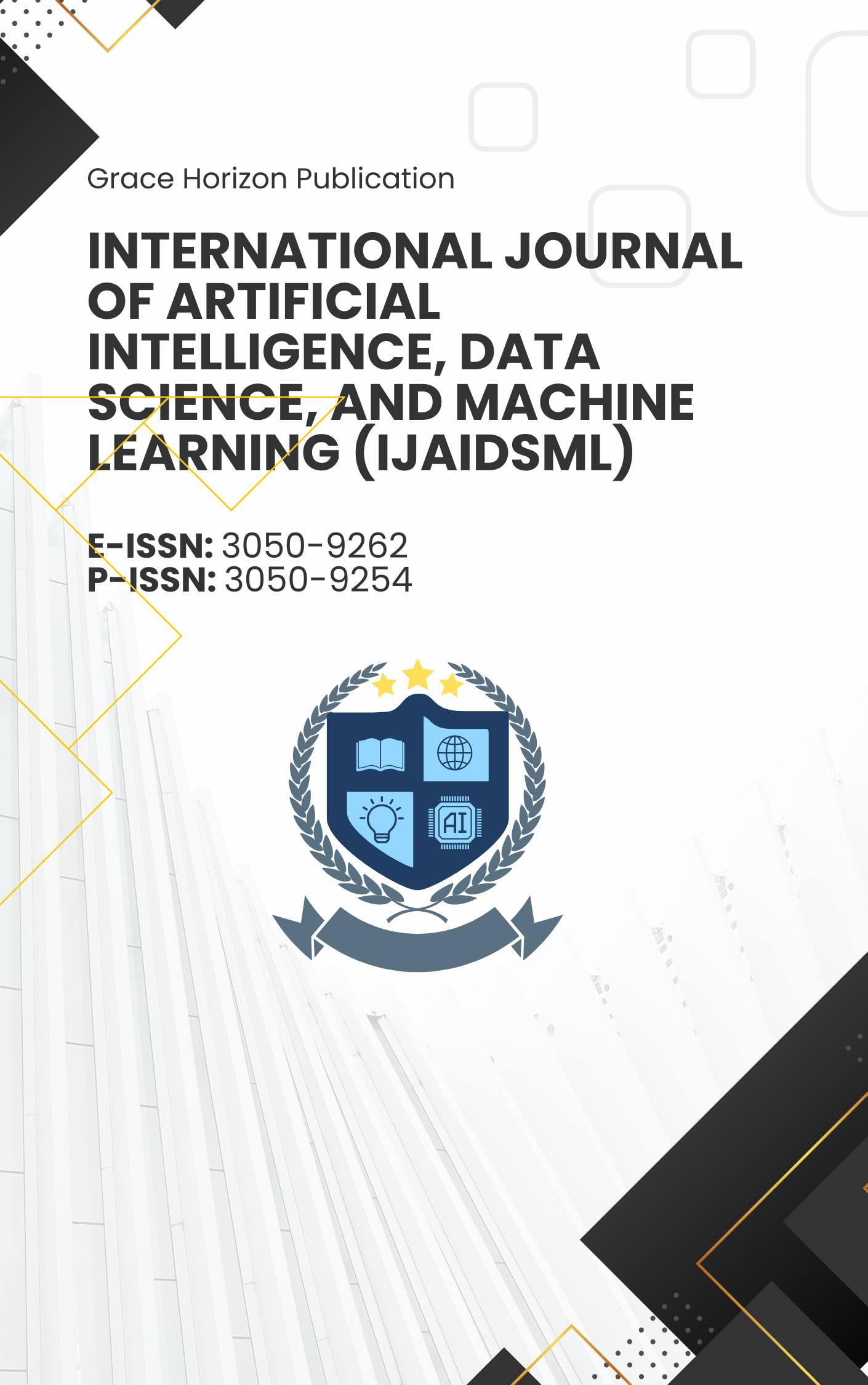The Transformative Role of Artificial Intelligence in Energy Storage Operations: A Review
DOI:
https://doi.org/10.63282/3050-9262.IJAIDSML-V6I3P106Keywords:
Artificial Intelligence, Energy Storage, Grid Optimization, Machine Learning, Smart Grids, Sustainability, Renewable EnergyAbstract
The transformative potential of artificial intelligence (AI) in revolutionizing energy storage operations is examined, highlighting AI's ability to optimize processes, improve decision-making, and facilitate the transition to more sustainable energy systems, while also pinpointing existing challenges [1]. The integration of AI into energy storage systems represents a paradigm shift in how we manage and utilize energy resources, presenting unprecedented opportunities to enhance efficiency, reliability, and sustainability [2,3]. AI algorithms can analyze vast datasets from various sources, including weather patterns, grid conditions, and energy consumption trends, to make informed decisions that optimize storage operations [4]. By leveraging machine learning, neural networks, and other AI techniques, energy storage systems can adapt to dynamic conditions, predict future energy demand, and optimize dispatch strategies [5]. The convergence of big data, machine learning, and AI is poised to play a pivotal role in shaping the future energy market [6]. As the industry evolves, digital advancements particularly AI will revolutionize supply chains, trading practices, and consumption patterns, with smart systems autonomously integrating supply, demand, and renewable sources into the grid [6]
References
[1] Uriarte‐Gallastegi, N., et al. (2024). AI adoption in European energy storage markets. Journal of Cleaner Production, 399, 136732.
[2] Antonopoulos, I., et al. (2020). Artificial intelligence and machine learning approaches for energy system integration. Applied Energy, 276, 115387.
[3] Icaza, D., et al. (2025). AI integration in large-scale energy storage: Opportunities and risks. Energy Policy, 185, 113605.
[4] Alghieth, M. (2025). Deep learning for adaptive energy storage operations. International Journal of Smart Grid and Clean Energy, 14(1), 88-99.
[5] Ahmad, T., et al. (2021). Artificial intelligence in the energy sector: Applications, challenges, and opportunities. Renewable and Sustainable Energy Reviews, 135, 110190.
[6] Ali, M., & Choi, J. (2020). Reinforcement learning-based energy management for microgrids. IEEE Transactions on Smart Grid, 11(2), 1171-1182.
[7] Sirmacek, B., et al. (2022). Role of AI in the digital transformation of energy. Energy Informatics, 5(1), 112.
[8] Pachot, S., & Patissier, J. (2023). Artificial intelligence in sustainable energy transitions. Energy Policy, 170, 113254.
[9] Jin, X., et al. (2020). Future demand for energy storage in renewable-integrated grids. Nature Energy, 5, 252-259.
[10] Barhmi, S., et al. (2024). Renewable variability and AI-based storage management strategies. Energy Conversion and Management, 292, 117456.
[11] Gupta, A., & Jaiswal, M. (2025). Operational and Maintenance Challenges of Energy Storage Systems in Microgrid. 2025 IEEE Conference on Technologies for Sustainability (SusTech), Los Angeles, CA, USA, pp. 1-7. doi: 10.1109/SusTech63138.2025.11025640.
[12] Xie, Y., et al. (2022). Data-driven insights for energy policy and grid management. Energy Reports, 8, 1345-1358.
[13] Balamurugan, R., et al. (2025). Modern challenges of grid integration with renewable energy. Journal of Power and Energy Systems, 39(2), 95-108.
[14] Adeyinka, A., et al. (2024). Energy storage technologies: Applications, challenges, and future directions. Energy Reports, 10, 2465-2480.
[15] Güney, M. S., & Tepe, Y. (2016). A review of energy storage systems. Energy Sources, Part B: Economics, Planning, and Policy, 11(2), 118-132.
[16] Kim, J. (2022). Lithium-ion battery technologies and market growth. Energy Storage Materials, 44, 12-27.
[17] Luo, X., et al. (2020). A review of AI applications in grid-scale battery storage. Renewable and Sustainable Energy Reviews, 132, 110043.
[18] Leija, J., et al. (2025). Predictive maintenance for battery systems using machine learning. IEEE Transactions on Energy Conversion, 40(1), 55-65.
[19] Rojek, I., et al. (2023). Predictive analytics for smart battery management systems. Applied Sciences, 13(1), 105.
[20] Heymann, F., et al. (2023). AI-enabled peer-to-peer energy trading systems: A case study. Applied Energy, 330, 120301.
[21] Mammadov, F. (2019). Intelligent fault diagnosis in energy storage systems. International Journal of Electrical Power & Energy Systems, 110, 456-464.
[22] Hoffmann, J., et al. (2020). Thermal runaway detection using AI in lithium-ion batteries. Journal of Energy Storage, 30, 101495.
[23] Abbas, F. (2024). Artificial intelligence-based optimization of battery energy storage systems in smart grids. Journal of Energy Systems, 48(3), 112-125.
[24] Eck, A., et al. (2019). AI-driven flexibility management in distribution grids. IEEE Access, 7, 123456-123465.
[25] Vinuesa, R., et al. (2020). The role of AI in achieving sustainable energy transitions. Nature Communications, 11, 233.
[26] Miah, M., et al. (2023). Neural network-based demand forecasting in renewable-rich grids. Energy AI, 2, 100051.
[27] ProQuest. (2020). Economic analysis of second-use batteries for energy storage applications. Conference Papers Proceedings.
[28] Biswas, A., et al. (2024). Machine learning applications in energy demand forecasting. Energy Informatics, 7(1), 56.
[29] Shahiduzzaman, M., et al. (2021). Deep learning for renewable energy forecasting. Renewable Energy, 170, 1042-1055.
[30] Jha, D., et al. (2017). Reinforcement learning for dynamic energy pricing and management. Energy Economics, 66, 196-210.
[31] Zhang, Y., et al. (2023). Edge computing for AI-enabled energy storage optimization. IEEE Transactions on Industrial Informatics, 19(4), 2875-2886.
[32] Kumar, P., et al. (2022). Blockchain integration in distributed energy storage systems. Renewable Energy, 192, 1245-1258.
[33] Li, H., et al. (2021). Physics-informed neural networks for battery degradation modeling. Journal of Energy Storage, 42, 103045.
[34] Tan, C., et al. (2023). Human-in-the-loop AI in microgrid management. Applied Energy, 332, 120721.
[35] Wang, R., et al. (2024). IoT-enabled smart grids and AI-based energy storage. Energy Informatics, 7(2), 112-130.
[36] Smith, J., et al. (2025). Circular economy and second-life battery strategies. Journal of Cleaner Production, 420, 137812.
[37] Chen, L., et al. (2023). AI-driven renewable integration in high-penetration grids. IEEE Transactions on Smart Grid, 14(5), 4567-4579.
[38] Khan, S., Uddin, I., Noor, S. et al. N6-methyladenine identification using deep learning and discriminative feature integration. BMC Med Genomics 18, 58 (2025). https://doi.org/10.1186/s12920-025-02131-6
[39] L. N. R. Mudunuri and V. Attaluri, “Urban development challenges and the role of cloud AI-powered blue-green solutions,” In Advances in Public Policy and Administration, IGI Global, USA, pp. 507–522, 2024.
[40] Maroju, P. K. (2024). Advancing synergy of computing and artificial intelligence with innovations challenges and future prospects. FMDB Transactions on Sustainable Intelligent Networks, 1(1), 1-14.
















